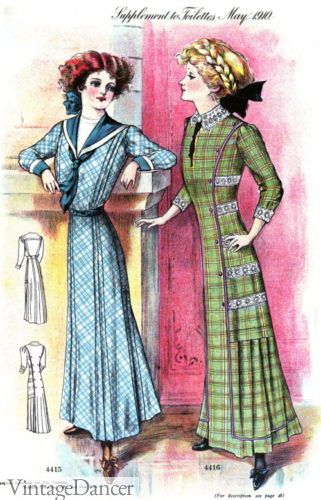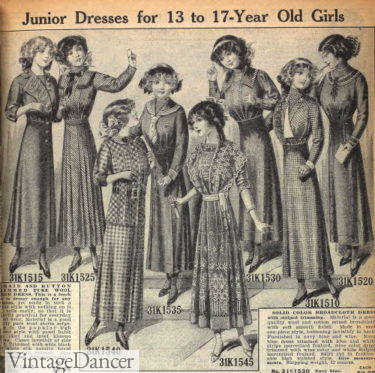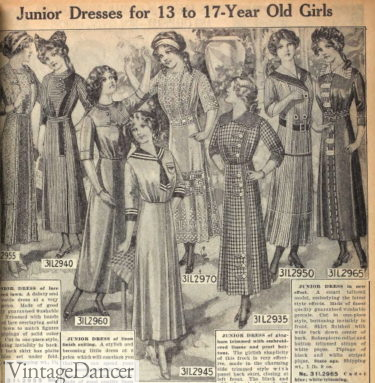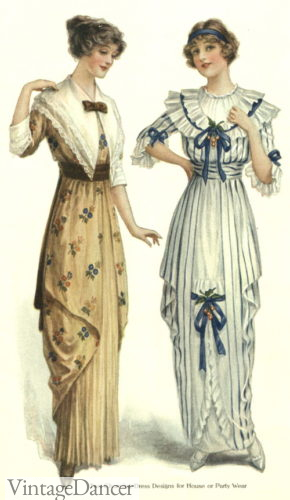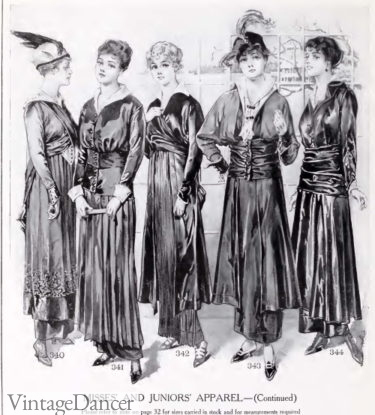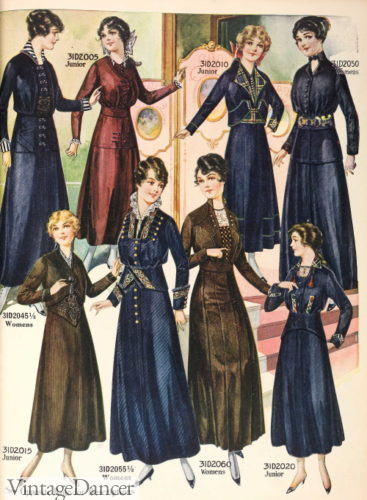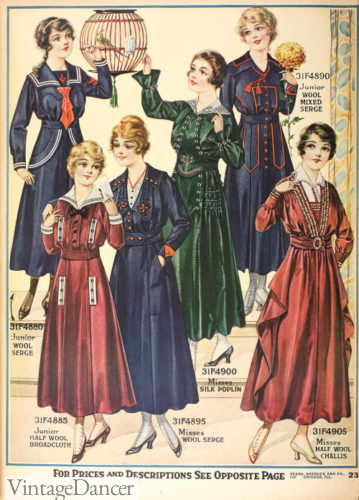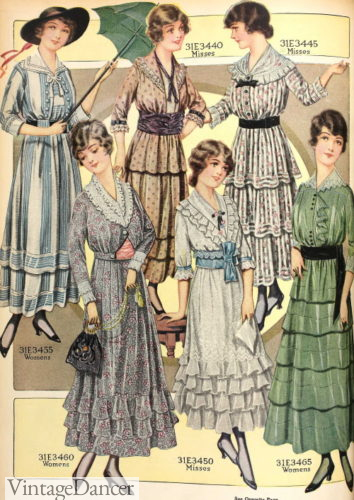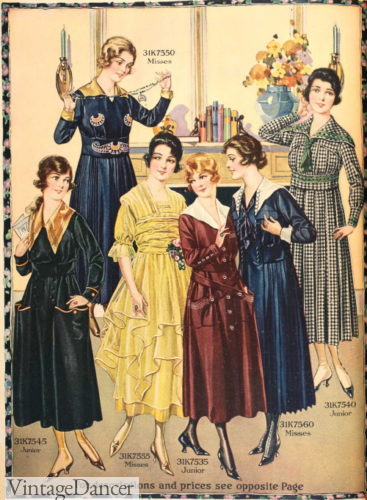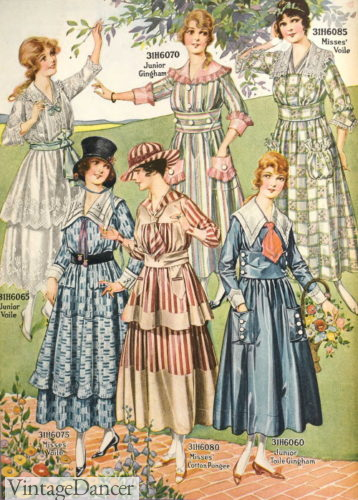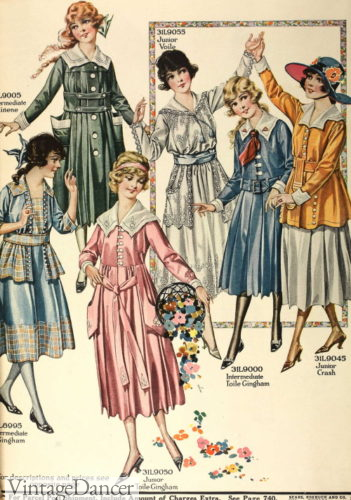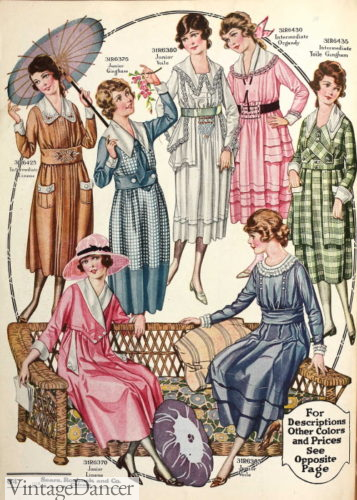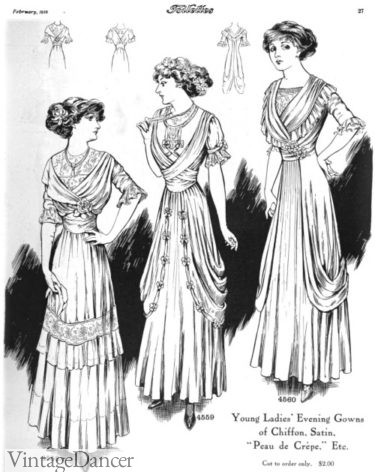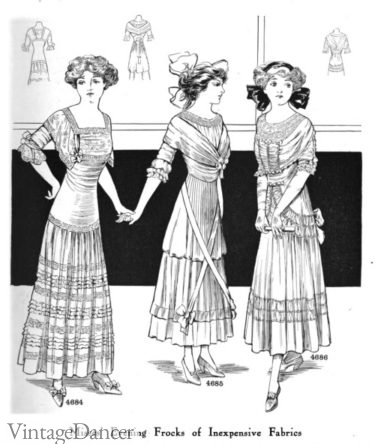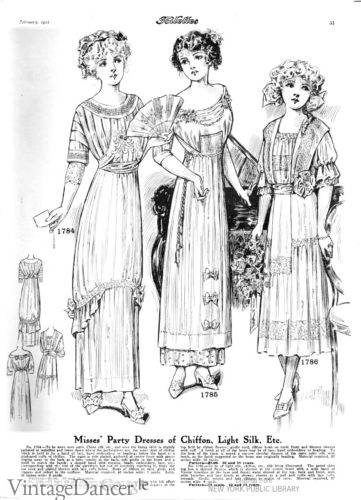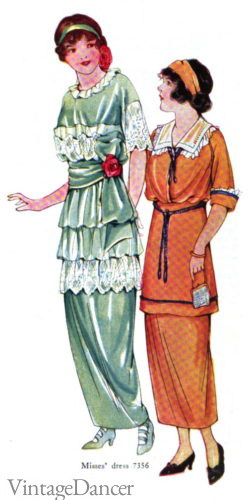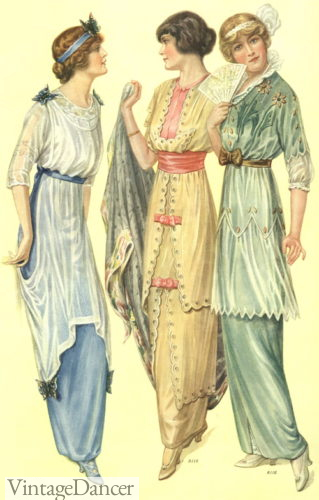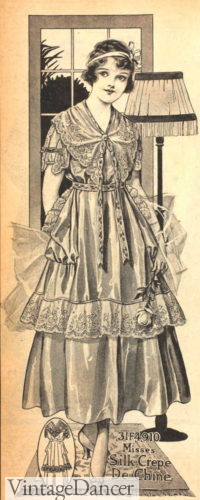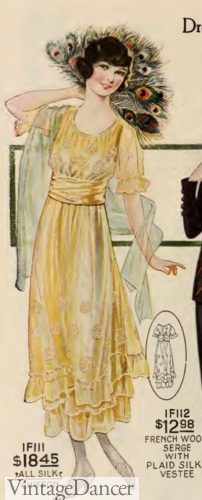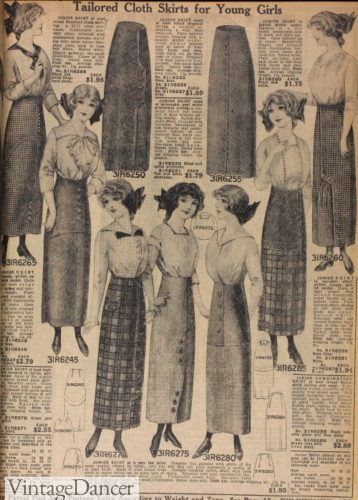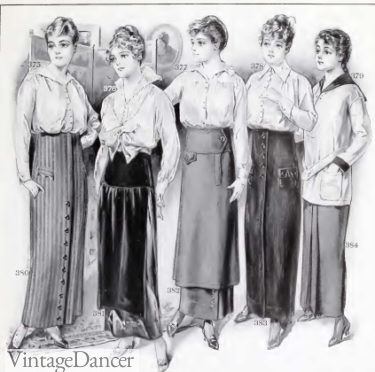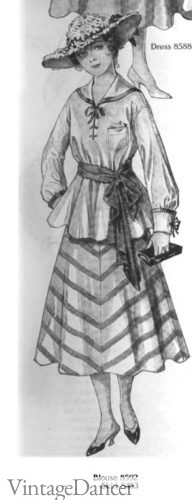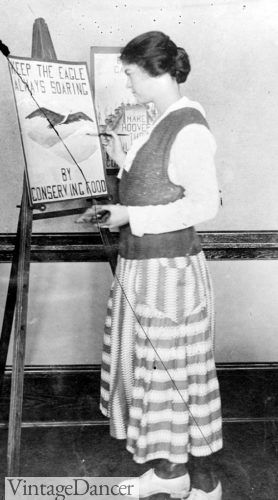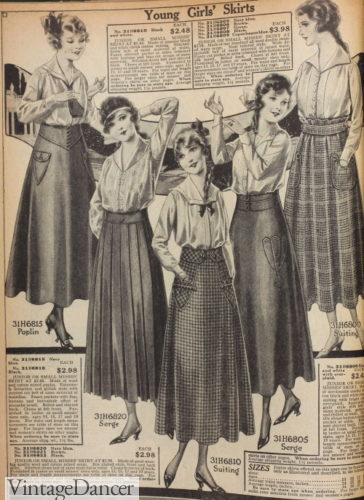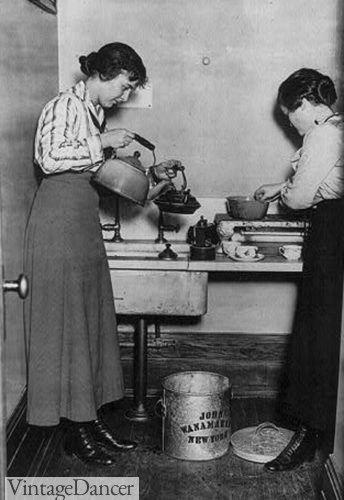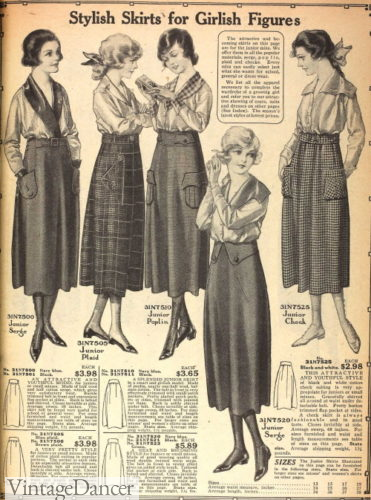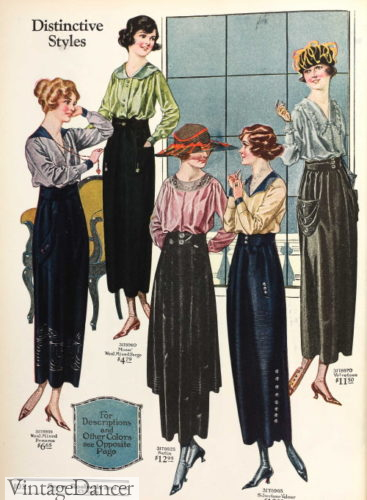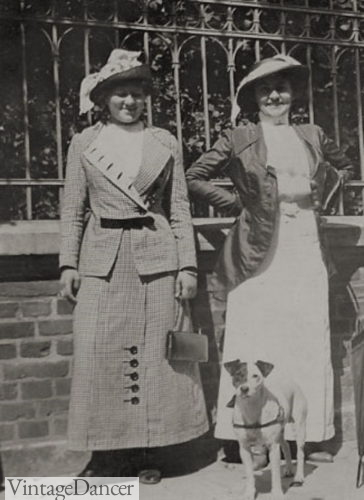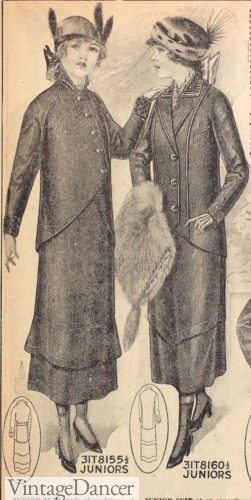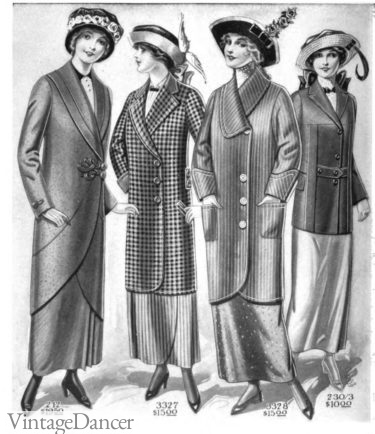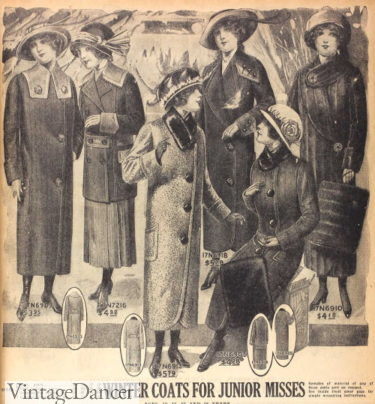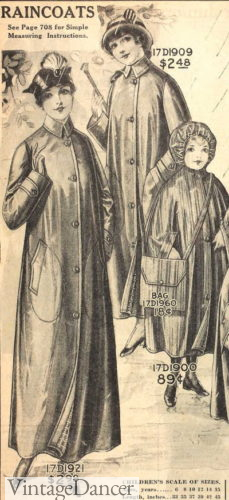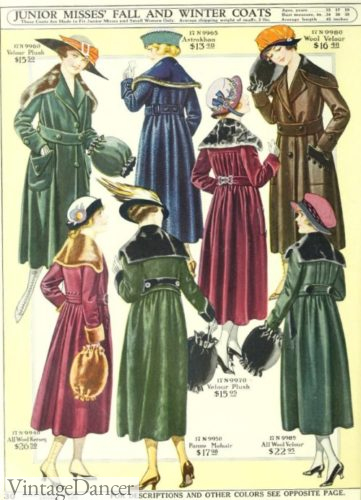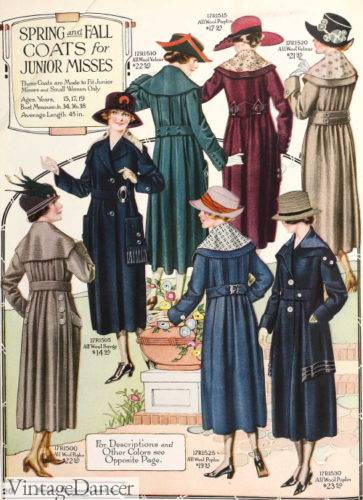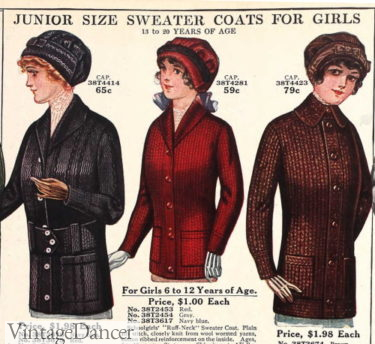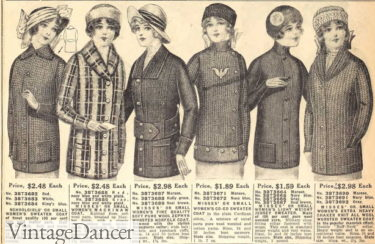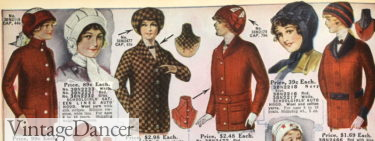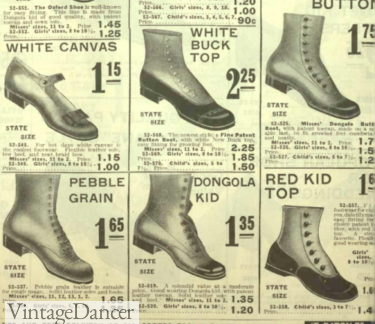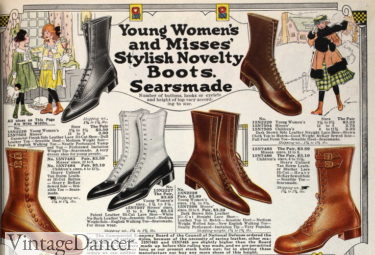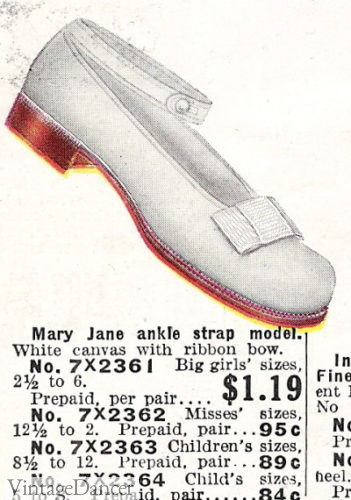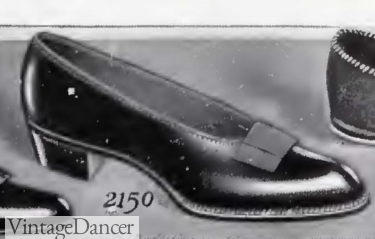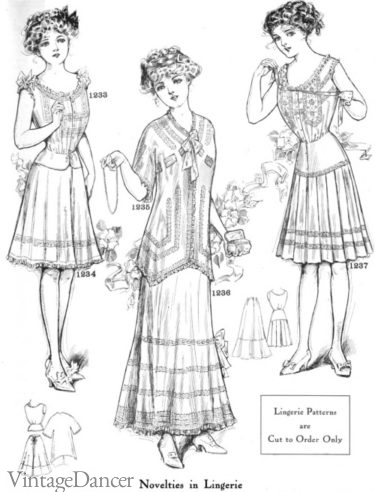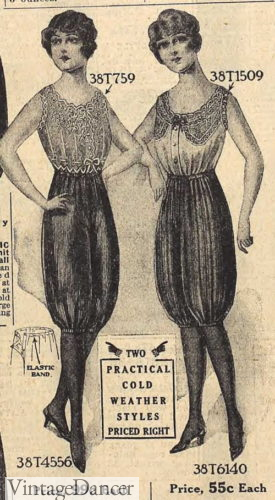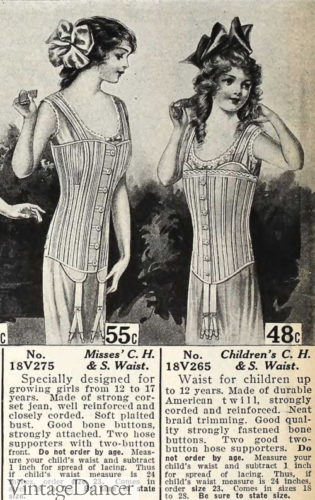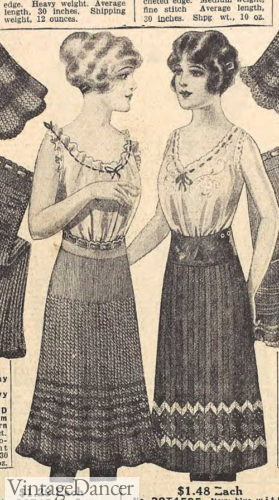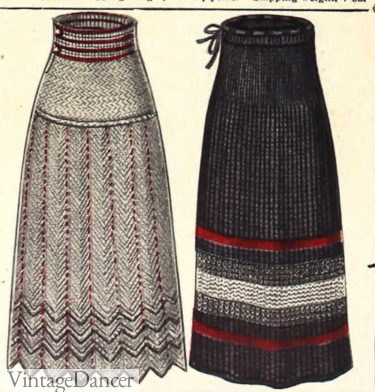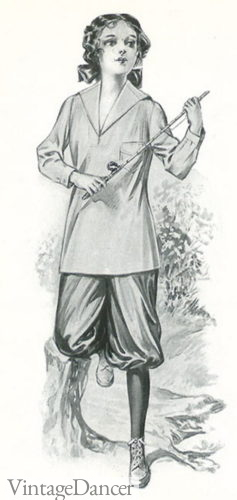The teenager and the high school girl, from ages 12 to 20, was at a crossroads in life and fashion. No longer suitable wearing the knee length ruffled dresses she wore as a young girl, nor ready for the maturity of women’s clothing, she found herself somewhere in between.
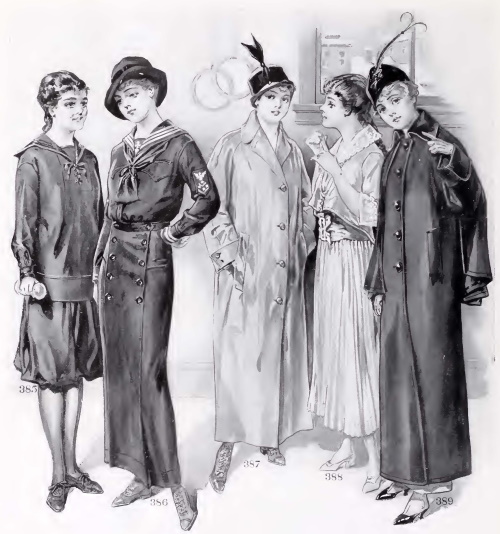
1914 Teen Girls’ Fashions
During WWI, when High School girls were being hired for jobs, retailers became aware of their new income. Dress makers and ready-to-wear clothing shops began catering to the “Junior Misses” by offering women’s clothing in smaller sizes and developing body shapes. It was the first time that you could say teenage fashion was born.
Although still heavily modified from women’s clothes, the teens had opinions on what they wanted to wear. Their spending power, their needs for more practical clothing, and their families’ desire to marry them well once the boys returned from War, each played a part in teen girls 1910-1920 fashion.
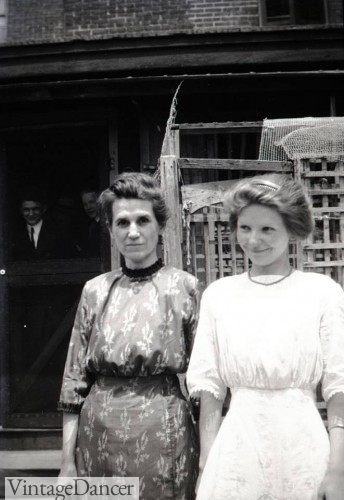
1911, Mother and Daughter in Simple Straight Line Dresses. Middle class.
Because fashion pivoted from before and after WWI, I have divided the clothing into 1910-1914 and 1914 to 1920 groups.
1910s Teen Girls’ Dresses
The Gibson girl silhouettes of the 1890s-1900s faded quickly after 1909, being replaced by a new slimmer shape. Teenagers, always eager to stay up to date with new fashions, adopted the new silhouette.
1910s teenage girls also increased their color palette from light pastels to medium tones of blue, green, wine, purple, navy blue, brown, and white. Popular patterns for day dresses were plaid, thin vertical stripes, and gingham checks.
- 1910 Day Dress in Plaid
- 1912 Day and Afternoon Dresses
- 1913 Daytime Dresses
- 1914 Teen Girls’ Afternoon Dresses
- 1914 Teen House vs Party Dress
- 1914 Teen Afternoon Dresses
During WWI, the slim silhouette was obsolete. Teens needed to take on a heavier physical role at home, school, and jobs. Skirts widened, tops became looser and fuller, and hemlines rose up a few inches. They kept on riding up to 2 inches below the knee by 1919.
The love for jewel tone colors dominated. Darker tones in winter and lighter white and pastels in summer. There were now more prints in bigger patterns: wide stripes, florals large and small, polka dots, and checkerboard. Teens and young girls, more than women, adored these fun prints.
Read about Edwardian House Dresses, 1900s – 1910s.
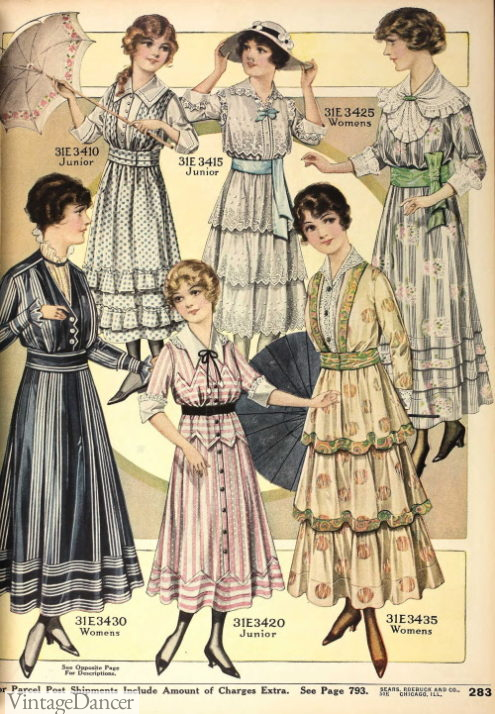
1916 Spring Dresses
The difference between women and teen dresses were minimal. Women’s clothes were more often trimmed in embroidery in muted colors, while girls’ dresses featured ruffles, big bows, white collars, tiered skirts, and sash belts in contrasting colors. Essentially the more child-like and “girly” the dress, the more youthful the design.
- 1915 Teen’s and Women’s Winter Dresses
- 1916 Day and Afternoon Dresses
- 1916 Spring Dresses – Day and Afternoon
- 1917 Teen’s and Women’s Dresses for Day and Evening
- 1917 Spring Dresses
- 1918 Spring Dresses
- 1918 Winter Dresses
- 1919 Spring Day Dresses
Party Dresses
Besides daywear, teenage girls often had special occasions to dress up. There could be parties and balls (if they were old enough to attend), semi-formal dances, church events, and school graduations. Teenage girl evening dresses followed the same trends as women’s dresses, although they were more modest (little skin showing) with elbow length sleeves until they reached a marriable age.
Like daytime dresses, teenager’s evening and party dresses were embellished in bows, lace sleeves, ruffles, silk flowers, and ribbon. The beauty was in the fussiness, instead of rich materials. Softer draping fabrics were chosen: silk crepe de chine, light satin, oriental lace, and chiffon.
For the hair, big bows, headbands, and flowers were placed in the back or on the side. Hair was gathered full around the face with a low chignon bun in the back.
Read more about evening gowns and party dresses.
- 1910 Evening Dresses
- 1910 Evening Dresses
- 1911 Party Dresses
- 1914 Day and Party Dresses
- 1914 Teen Dancing Dresses
- 1916 Party Dress in Light Blue
- 1918 Party Dress in Pink or Nile Green
- 1919 Party Dress in Yellow
A white graduation dress was an important item for a middle- to upper-class girl. Finishing school and being ready to go to college or marry was a celebration. Graduation dresses could be any white dress, but it was often a party dress or evening dress. Later, it could be dyed a color and taken to a dance or left white and passed on to another graduating girl or even worn to get married in.
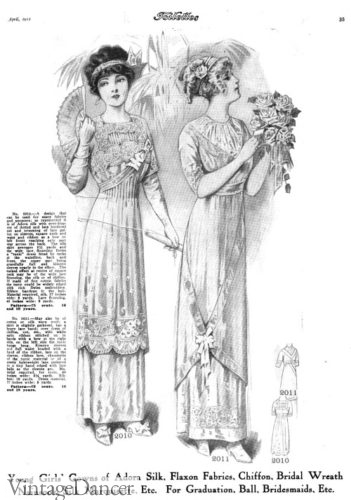
1911 White Graduation Dresses
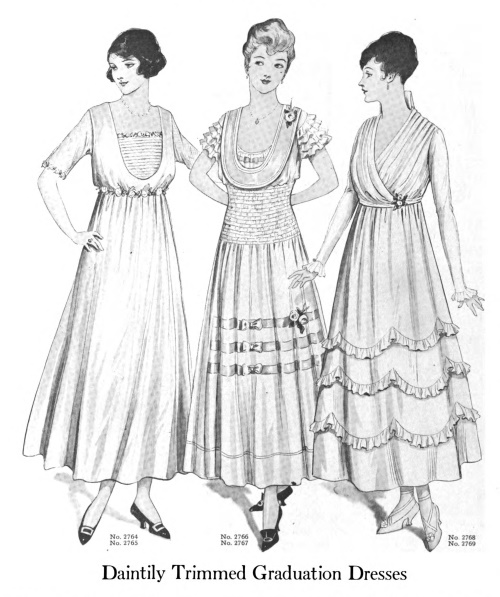
1915 Graduation Dresses
Skirts & Blouses
Dresses were well and good for most girls, but teens really like separates. A skirt and blouse with a top coat or sweater was all she needed to attend school, work a job, play a sport, or help around the house. This carryover style from the Edwardian Gibson girl era was not out of style for the teenage girl.
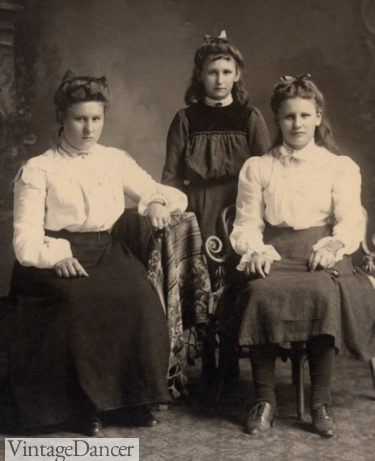
The Teen has a Long Skirt, Whereas her Young Sister’s Hem is at the Knee. 1910
Skirts narrowed down into columns for the first few years with blouses, called waists, equally fitted. The WWI years saw skirts go back to full width with fluffy blouses with wide collars to match. While white was the predominate blouse color, soft jewel tones came into vogue after the War.
Read about women’s 1910s skirts.
- 1914 Girls’ Skirts and Blouses
- 1914 Skirts and Blouses for Teens and Women
- 1916 Sailor Themed Skirt and Tunic Top
- 1919 Skirt with Knit Vest and Oxford Shoes
- 1917 Skirts and Blouses
- 1917 Barnard College Girls in Skirts and Blouses
- 1918 Skirts for Teens
- 1919 Skirts and Colored Blouses
Two piece tailored suits for teenagers were less common than for women. They may have worn one for traveling or doing volunteer work, but overall they were too grown up.
- Walking Suits for these Teens
- 1914 Suits for Teens
Teen Girls’ Coats
Girls’ and teens’ winter coats were, again, in the same styles as women’s coats. Long overcoats of wool or fur, trimmed in fur cuffs and collars with a matching fur muff, did well to keep a girl warm. For wet weather, there were long raincoats.
The teen girl, when weather allowed, preferred the newer sport short coats made of mackinaw wool fabric or the even shorter Norfolk style jacket. They came down only to mid thigh or the low hip. They looked best with practical skirts but could also be worn with daytime dresses.
- 1913 Short Coats and Norfolk Style Jacket
- 1913 Long Coat and Short Mackinaw
- 1915 Rain Coats
- 1918 Coats
- 1919 Teen Coats
Cardigan Sweaters
Knitwear sweaters and cardigan coats were very popular with teen girls. They were warm, casual, and not as stiff as a heavy coat — and they layered well over blouses and skirts. In winter, they paired with knit skirts for a skating/snow play outfit.
Most sweaters were long cardigan styles with buttons down the front and sometimes belts and pockets around the hip or low waist. Collars could be high rolls, shawls, and wide fold-downs. The blazer style sweater-coat came in bold plaid and checkerboard patterns. Teens loved those. Read more about women’s sweaters here.
- 1914 Sweaters
- 1914 Sweaters
- 1913 Sweaters and Blazer Coat
Shoes
Women, teens, and girls wore boots. All day, every day, unless it was an evening affair. Boots could be black, brown, or two tones of white or grey tops. Button-over “spat” style boots were trendy as well as lace up boots. Girls boots had a round toe box and wider fit while women’s and teen’s had a narrow fit with pointed toe.
For white dresses and summer sports, a white canvas Mary Jane flat with ankle strap was the best choices. For evening, a slip on pump with a flat bow on the toe was made in satin or patent leather. Read about women’s shoes and boots.
- 1916 Girl and Teen Button Boots
- 1918 Lace Up Boots
- 1914 Canvas Ankle Strap Mary Jane Flats
- 1914 Evening Pumps
Hats, Lingerie & Accessories
Look around at the photos on the page and you will see only a few hats worn by teens. Teens didn’t need to wear a hat unless it was an outdoor event or special occasion. Those that did wear hats kept them simple with narrow brims and a round crown. Read more about Edwardian hats here.
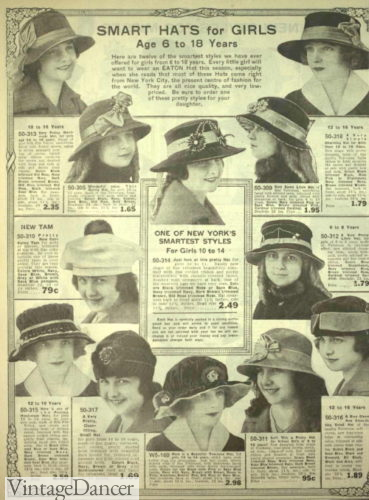
1918 Hats for Older Girls and Teens
Stockings. Teen wore black stockings most days. They were thigh high and tied into place with a ribbon. If she was wearing a corset or waist she could attach the stockings with a hose supporter/garter clip. If she wore a white or pastel party dresses her silk stockings would be white or a color to match the dress. Read about 1910s stockings.
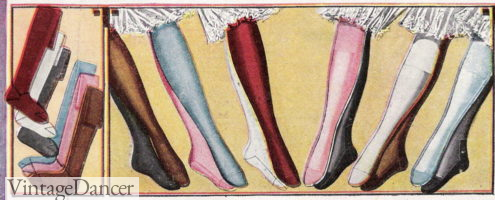
1914 Knit and Silk Stockings
Lingerie consisted of a chemise (a long cotton slip), drawers or bloomers as underwear, a petticoat (flannel, knitted, or cotton), and an optional waist (training corset). Waists could be underbust or overbust. They had cording or flexible stays to make them more bendable than women’s steel boned corsetry. Click here to read about lingerie.
- 1910 Lingerie Sets
- 1914 Bloomers and Chemise
- 1915 Training Corset
- 1915 Girls’ and Teen’s Waists
- 1914 Knit Petticoats
- 1914 Knit Petticoats
Sportswear
Swimwear was identical to women’s swimsuits. Read about them here.
Read 1900-1910s Hiking, Camping, Sport Clothes for Women.
Girls and teens wore a certain style of outfit to play sports (archery, tennis, shooting, bowling, etc). The sailor inspired Middy blouse paired with a skirt served women well. The middy top found its way onto many girls’ “sailor” dresses too.
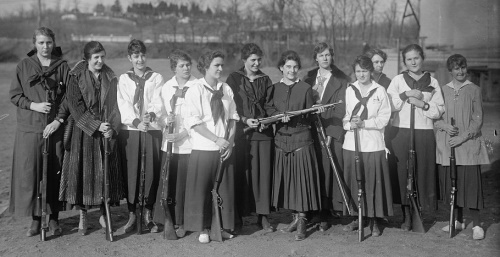
1916 Western High School Shooting Club Girls
For more active sports (basketball, baseball, hiking, fishing) or gymnasium class, girls changed out the skirt for a pair of baggy bloomers. These “gym suits” were the closest things teenagers could wear to pants. Read more about vintage gym suits from the 1920s onward.
- 1910 Bloomers with Attached Top
- 1913 Bloomer and Middy Top
Hair and Makeup
Click here to read about 1910s makeup.
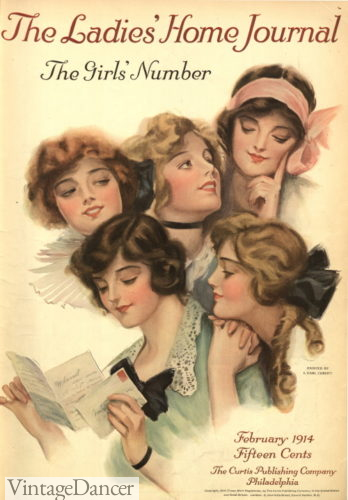
1914 Hair and Makeup for Teens
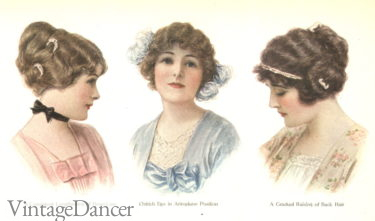
1914 Evening Hairstyles
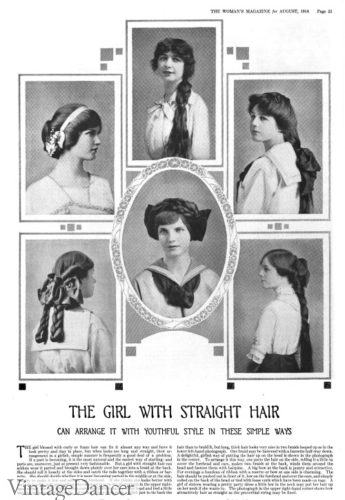
1914 Long Hairstyles
More?
It is impossible to cover everything a teenage girl in the 1910s worn in one article. Please feel free to send me your questions.
Use the 1900s menu to find more articles and shop for 1910s style clothing. Most links are in women’s sizes but many, especially those made in Asia, run small enough for a teen or tween to wear. I also have some links to children’s sizes here.
For a modern take on Edwardian -1910s fashion, look at the CottageCore Trends.
Additional Research
- This YouTube video shows 45 photos of teenagers from 1910s
- The Girl’s Own Paper and Women’s Magazine – A magazine of interest to girls and teens 1880s to 1930s at FSU
- Ladies Home Journal, Delineator, American Cloak and Suit, and other dressmaker magazines (sewing patterns) usually have patterns for girls and teens within childrenswear.
- Clothing catalogs Sears, Montgomery Wards, Simpsons, and others each have older girls’ and young misses clothing.
- 1920s Teenage Girls Fashion
- 1930s Teenage Girls Fashion
- 1940s Teenage Fashion: Girls
- 1950s Teenager Fashions
Debbie Sessions has been teaching fashion history and helping people dress for vintage themed events since 2009. She has turned a hobby into VintageDancer.com with hundreds of well researched articles and hand picked links to vintage inspired clothing online. She aims to make dressing accurately (or not) an affordable option for all. Oh, and she dances too.
